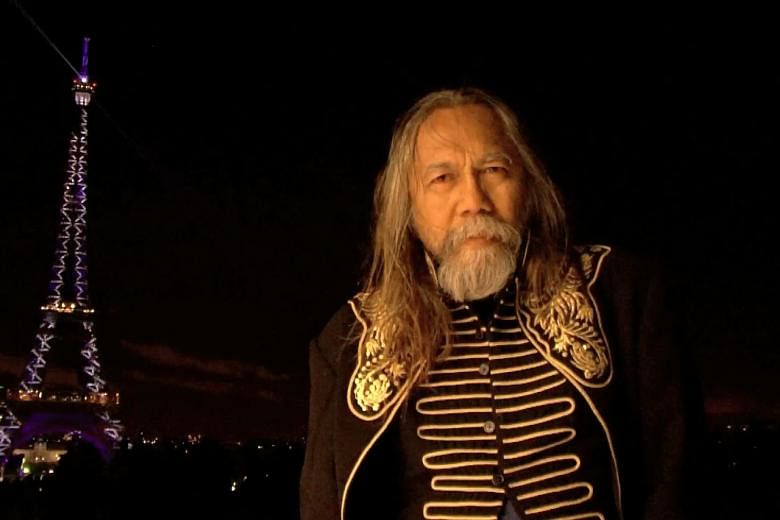A solar eclipse in March inspired Indonesian artist Sardono Waluyo Kusumo to create Black Sun, a dance piece expressing the plight of boat people afloat on the seas with no refuge in sight.
Commissioned by the Singapore International Festival of Arts, Black Sun premieres here on Aug 26. It is part of a two-week retrospective of the life and work of this pioneering choreographer, dancer and film-maker.
Sardono, 71, was considering the harsh living conditions of the refugees crammed together on open boats with no shelter from the sun when he took a photo of the solar eclipse on March 9.
"I saw strange cloud-like formations of people lining the black sun," he says in an e-mail interview. "For me, it was kind of a poetic image, which became my inspiration for the movement and choreography of the Black Sun performance. The photograph itself turned into a painting on a 3x20m canvas."
Sardono combines the rhythms of dance, music and paint in live painting performances where he uses Chinese ink, watercolour and acrylics to create large works on linen and cotton canvases.
One such performance is on this weekend at the Malay Heritage Centre, where there is also an ongoing showcase of his experimental films and archive footage of his creative process, shot since 1970.
-
BOOKIT /THE SARDONO RETROSPECTIVE
EXPANDED CINEMA
WHERE: Malay Heritage Centre, 85 Sultan Gate
WHEN: Until Aug 28, 11am to 9pm, Tuesday to Sunday
ADMISSION: Free
SOLO LIVE PAINTING
WHERE: Malay Heritage Centre
WHEN: 5pm, Saturday and Sunday
ADMISSION: Free
BLACKSUN
WHERE: 72-13 Mohamed Sultan Road
WHEN: 8pm, Aug 26 and 27
ADMISSION: $30 (with free admission to Solo Live Painting) from Sistic
Among the films shown in this Expanded Cinema showcase are his tribute to the late 19th century Javanese realist painter Raden Saleh, who lived in Paris and counted novelist Alexandre Dumas as a friend. In tribute, Sardono donned period clothing and frequented Raden's haunts.
To him, "there is no separation between learning dance, music and making films, painting or becoming a storyteller".
"Since I was a child, learning art means training all the senses... and also being trained in storytelling, writing narratives and literature. This means I have to learn the patterns of dance, such as gamelan music.
"I have to know how to write and draw the classical wayang figure. I have to learn by heart the Mahabarata, Ramayana and also local history and mythologies. During the entirety of my life I have to train the sensibilities towards complexity."
Sardono began his training at age eight, studying the Javanese martial art pencak silat at his father's urging. His father was a pharmacist and his mother had a business in batik.
Martial arts led to Javanese dance, which he learnt under masters such as Djoko Soehardjo and RT Kusumo Kesowo.
In 1961, Sardono made his mark with a showcase of 250 dances at a Hindu temple complex outside Yogyakarta. Three years later, he represented Indonesia at the New York World's Fair and went on to make numerous appearances at festivals in Asia, Europe and the Americas.
In 1968, he became the youngest member of the Jakarta Arts Council. In the 1970s, he founded the country's first experimental dance company Dance Theatre Sardono and began teaching at the Jakarta Institute of Arts. He was appointed its rector in 2005.
His list of honours include the well-known Prince Claus Award in 1997, awarded by the Netherlands to outstanding artists in Asia, and Indonesia's Cultural Merit Star or Bintang Budaya Parama Dharma in 2003, which is awarded to artists who promote and preserve Indonesian culture and art.
Sardono is a contemporary choreographer but he unites modern sensibilities with tributes to the varied traditional arts of the archipelago. Black Sun is presented with dancers from Papua and is inspired by Sardono's research into that environment and culture.
Nature and mythology inspire his practice. He says: "In the Ramayana and Mahabharata epics as well as in wayang wong (classical Javanese theatre) and shadow play performances, the stories are always about the forest, flora and fauna. These have thus become a major inspiration of mine.
"I am so grateful to be an Indonesian because I have easy access travelling into the jungles of Kalimantan, Sumatra, Papua and even Java."
He is a passionate advocate for the preservation of the rainforest environment. He raises funds for tribes whose health and livelihood suffer during large forest fires.
He takes students from the Jakarta Institute of Arts camping in the rainforests so they have the experience of living near the Dayak tribes and learning traditional tribal dances.
While Black Sun to him is about the plight of refugees, to many in Singapore, the title might bring memories of the yearly haze that arises from forest fires in Indonesia. Sardono does not mind.
"I never expect something from the audience at my performances. I just let them feel the experience and bring home their own creative interpretations of the performance," he says.
Correction Note: An earlier version of this story said that there is a $10 admission charge for Solo Live Painting. It has been corrected to say that admission to the event is free.


